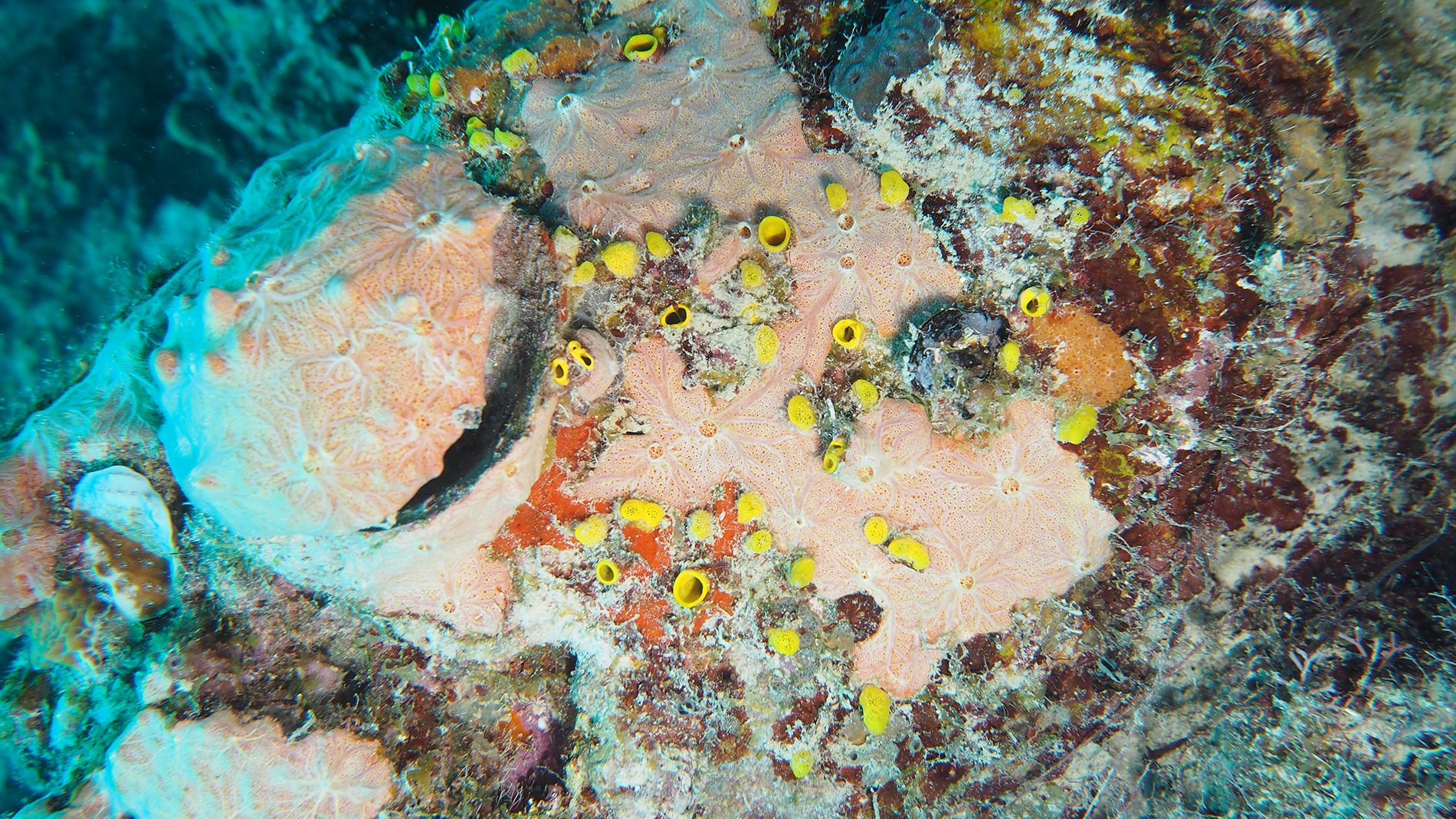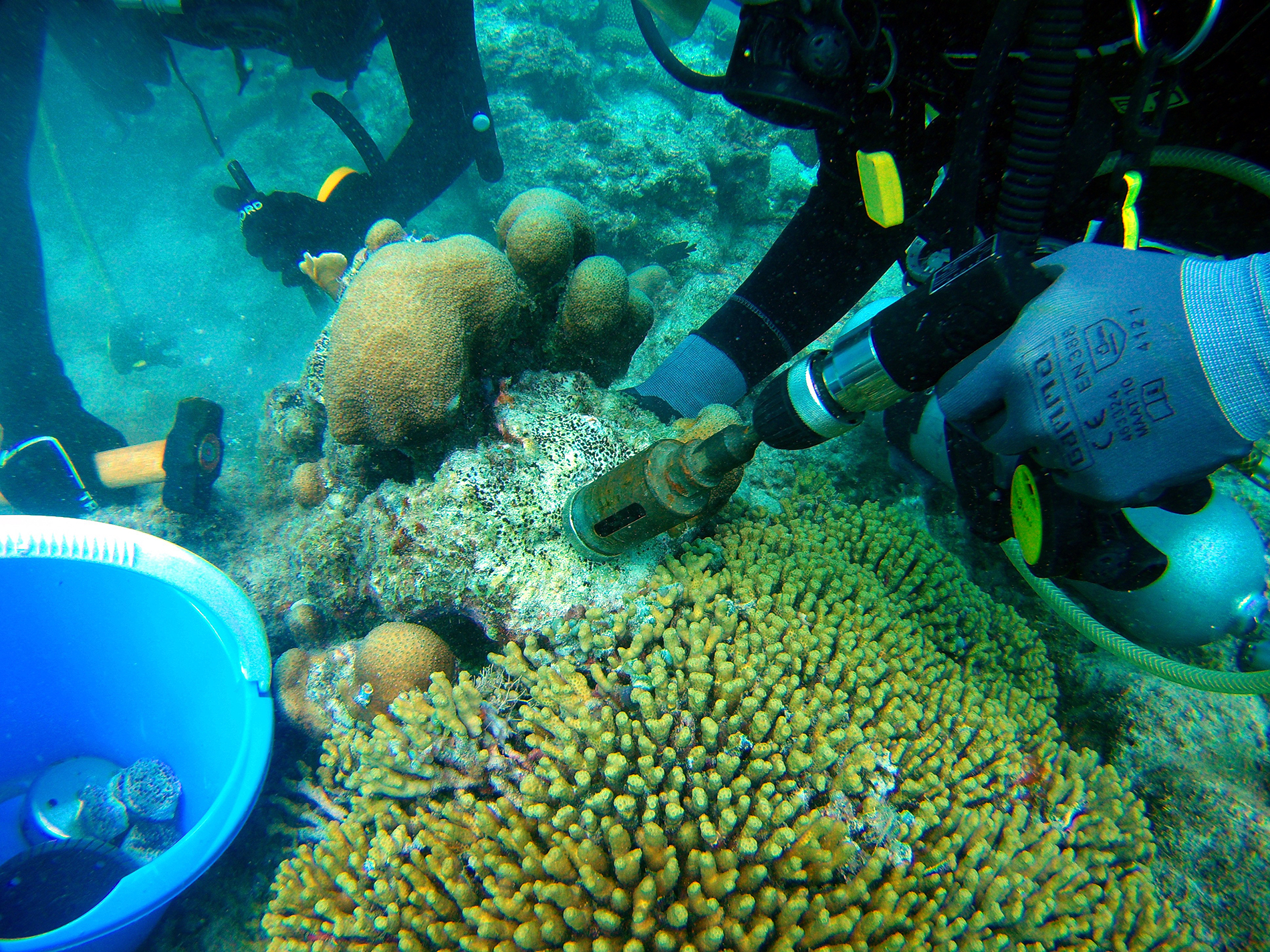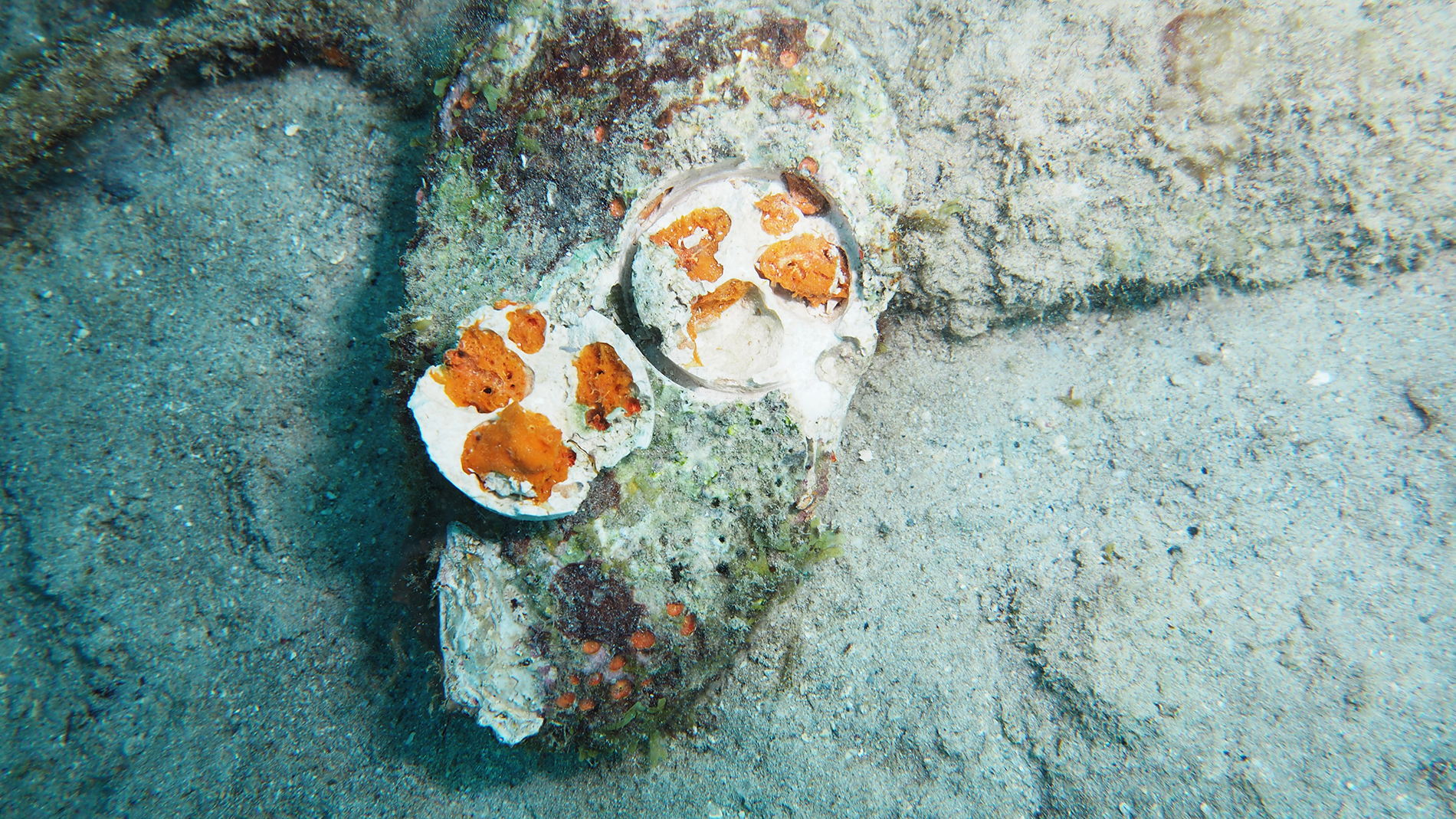How sponges undermine coral reefs from within
Coral reefs are demolished from within, by bio-eroding sponges. Seeking refuge from predators, these sponges bore tunnels into the carbonate coral structures, thus weakening the reefs. Scientists from the Royal NIOZ Netherlands Institute for Sea Research have uncovered how the sponges hollow out and take over reef skeletons. This finding, published in Scientific Reports on Thursday January 24th, helps to explain why sponges erode reefs faster as atmospheric CO2 levels rise. ~~~ Scroll naar beneden voor Nederlands ~~~
With their three-dimensional structures, coral reefs provide ecosystem building blocks, hotspots for living organisms and natural coastal protection against waves. Worldwide, coral reefs are under pressure of the consequences of climate change, such as ocean acidification. NIOZ-first author Alice Webb explains why and how sponges contribute to the collapse of coral reefs.

Why and how do sponges excavate coral reefs?
An affected coral reef may seem intact on the outside, while on the inside looking like a complex of mining shafts with galleries and cavities that are completely filled with sponge tissue. Bio-eroding sponges bore into coral skeletons, not to feed on the calcium carbonate, but to protect their own tissue from predators by hiding in the hard coral structure. To make the tunnels, they use a combination of chemical and mechanical demolition techniques. First the sponge pumps acidified fluid onto the coral to dissolve and chip off calcium carbonate pieces; then it removes the chips from the boring pit by contracting its tissue, resembling smooth muscle tissue. Sponges filter huge amounts of water constantly for feeding and breathing. They suck in water, take all the food particles and then spit the filtered water out. Chips of coral reef are expelled by the same route through these filtering canals, and out of the sponge through the so-called osculum.
How does ocean acidification help sponges break down coral?
We knew from previous research that bio-erosion is facilitated by higher CO2 levels, but we didn’t know why. Bio-eroding sponges alter the chemical composition of the water at the etching interface by pumping protons from the surrounding seawater into this interface. By doing so, they make the surface of the skeleton more acidic, which helps to dissolve the skeleton. If more CO2 is dissolved in the seawater, the proton concentration rises and the sponge will simply have to spend less energy on lowering the pH at the sponge/coral interface.
Why was the breaking-down mechanism still unknown?
The sponge-coral interface is extremely hard to localise and observe as it is surrounded by layers of coral skeleton. Research on boring mechanisms of bio-eroding sponges really started in the 1970s, but the technology to look at differences in pH was not available. In the last decade, researchers have tried to localise the etching site using microelectrodes (pH probes) but this approach did not succeed. We combined a number of ‘tricks’ to open up the sponge-carbonate boundary. We grew sponges on small pieces of calcite minerals that we could manipulate to observe the sponge-carbonate interface directly. The actual observation was done using fluorescence microscopy by visualising pH (acid) and the way the pH was controlled by the sponge.
What are the implications of your findings?
These sponges are abundant on reefs of the Caribbean such as Curacao, Saba bank or Florida keys, but also on the Great Barrier Reef. Taking ocean acidification into account, our sponge findings make it possible to make better predictions of future coral reef conditions.
Article
Alice E. Webb, Shirley A. Pomponi, Fleur C. van Duyl, Gert-Jan Reichart & Lennart J. de Nooijer
pH Regulation and Tissue Coordination Pathways Promote Calcium Carbonate Bioerosion by Excavating Sponges
Scientific Reports Nature. DOI: https://doi.org/10.1038/s41598-018-36702-8
Hoe sponzen koraalriffen van binnenuit slopen
Koraalriffen worden van binnenuit afgebroken door bio-eroderende sponzen. Om zichzelf te beschermen tegen roofdieren, verschansen deze sponzen zich in zelfgemaakte tunnels in de harde koraalstructuren. Daarmee verzwakken ze het koraalrif. Wetenschappers van het NIOZ Koninklijk Nederlands Instituut voor Onderzoek der Zee hebben ontdekt hoe de sponzen het koraal uithollen en bezit nemen van hele riffen. De bevindingen werden op donderdag 25 januari gepubliceerd in Scientific Reports, en verklaren ook waarom sponzen het koraal sneller slopen, naarmate het CO2-niveau in de atmosfeer stijgt.
De driedimensionale structuren van koraalriffen vormen de bouwstenen voor het ecosysteem en dienen als trekpleister voor planten en dieren en natuurlijke kustbescherming tegen golfslag. Wereldwijd staan koraalriffen onder druk door de gevolgen van klimaatverandering, zoals oceaanverzuring. NIOZ-onderzoeker en eerste auteur Alice Webb legt uit waarom en hoe sponzen sneller bijdragen aan de instorting van koraalriffen.

Waarom en hoe hollen sponzen koraalriffen uit?
Een aangetast koraalrif ziet er aan de buitenkant misschien intact uit, maar aan de binnenkant lijkt het meer op een mijnschachtencomplex met tunnels en holtes die volledig zijn gevuld met sponsweefsel.
De reden dat bio-eroderende sponzen in het koraal doordringen is niet om zich te voeden met het calciumcarbonaat, maar om zich te verstoppen in het harde koraal en zo hun eigen weefsel te beschermen tegen roofdieren. Om de tunnels te maken, gebruiken de sponzen een combinatie van chemische en mechanische slooptechnieken. Eerst pompt de spons water verzuurd water op het koraal om brokjes calciumcarbonaat op te lossen en los te weken; vervolgens werkt de spons elk brokje naar buiten door zijn weefsel, wat lijkt op glad spierweefsel, samen te trekken. Sponzen filteren al voortdurend enorme hoeveelheden water om adem te halen en om te eten. Ze zuigen water naar binnen, filteren de voedingsdeeltjes eruit en spugen het gefilterde water weer uit. Ook de brokjes koraal die de spons heeft losgeweekt werkt hij via dezelfde route van filterkanalen en de zogenaamde osculum naar buiten.
Hoe helpt oceaanverzuring sponzen bij het afbreken van koraal?
Uit eerder onderzoek wisten we al wel dat bio-erosie wordt vergemakkelijkt door hogere CO2-niveaus, maar we wisten niet hoe dat komt. Bio-eroderende sponzen veranderen de chemische samenstelling van het zeewater op het raakvlak tussen spons en koraal door er protonen uit het omringende water tegenaan te pompen. Door dit te doen maken ze het oppervlak van het koraalskelet zuurder, en daarmee lossen ze het koraal op. Als er meer CO2 in het zeewater wordt opgelost, verzuurt de oceaan en stijgt dus de protonconcentratie, waardoor het de spons eenvoudig minder energie kost om de pH te verlagen tussen spons en koraal.
Waarom is de slooptechniek van de spons niet eerder ontdekt?
De overgang tussen spons en koraal is extreem moeilijk te lokaliseren en te observeren omdat het omgeven is door lagen koraalskelet. Je komt er niet goed bij. Al in de jaren '70 begon het onderzoek naar de sloopmechanismen van bio-eroderende sponzen, maar de huidige technologie om verschillen in pH vast te stellen was nog niet beschikbaar. De afgelopen tien jaar hebben onderzoekers wel geprobeerd het raakvlak tussen spons en koraal te lokaliseren met behulp van micro-elektroden (pH-sondes), maar deze aanpak mislukte. Wij hebben een aantal 'trucs' gecombineerd om de grens tussen spons en koraal te openen. We lieten sponzen groeien op kleine blokjes calciumcarbonaat die we konden manipuleren om de spons-koraal-overgang direct waar te nemen. Met behulp van fluorescentiemicroscopie konden we visualiseren hoe de spons de pH-waarde regelt.
Wat zijn de implicaties van jullie bevindingen?
Deze sponzen zijn overvloedig aanwezig op riffen van de Caraïben, zoals op Curacao, de Saba bank en de Florida Keys, maar ook op het Grote Barrièrerif bij Australië. Met onze sponsresultaten is het mogelijk betere toekomstvoorspellingen te doen over de conditie van deze koraalriffen bij voortschrijdende oceaanverzuring.
Artikel
Alice E. Webb, Shirley A. Pomponi, Fleur C. van Duyl, Gert-Jan Reichart & Lennart J. de Nooijer
pH Regulation and Tissue Coordination Pathways Promote Calcium Carbonate Bioerosion by Excavating Sponges
Scientific Reports Nature. DOI: https://doi.org/10.1038/s41598-018-36702-8

